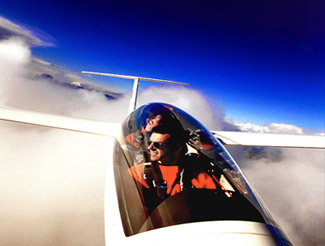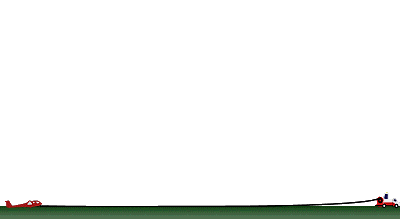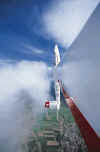

Gliding is the ultimate free flying experience. It is a truly diverse sport that can be enjoyed at all levels: from the thriving club scene, to aerobatics, to the international racing competitions, currently dominated by British pilots (with five World Champions).
The gliders you can fly soar using the same air currents that birds use to fly, but have also been designed with the kind of aerodynamic efficiency that enables top speeds of up to 170 mph. Distances of over 600 miles have been covered in one day in the UK and heights of almost 40,000 feet have been achieved. Gliding gives you the freedom to explore the world from a unique birds eye view and discover the many moods of the sky.
You may already have an interest in aviation but perhaps you have not yet discovered the joy and excitement of gliding. If this is the case let us share with you our enthusiasm for what we regard as the ultimate sport. Gliding, sometimes called soaring, is motorless flight. Gliders use naturally occurring atmospheric phenomena, called "LIFT", to gain altitude and stay aloft.
Methods of Launch
A sailplane is either launched by a power plane, by winch (a wire attached to a powerful engine which heaves the glider up to 2000ft into the sky) or by bungy.
Click to enlarge
The bungy is the oldest and perhaps the most interesting method of launch. In this method the glider is perched on the top of a ridge and a length of rubberised rope is attached to the towhook. Teams of runners on each side of the nose tear down the hill catapulting the glider into the air streaming up the face of the ridge.

Aerotow launches are a widely used method of getting the glider airborne. The glider is pulled aloft by a rope secured by a special hook to the towplane. The glider pilot can release the towrope at any height desired.

Winch launching is achieved by attaching a long wire to a powerful engine and then pulling the glider rapidly down the runway. The glider can achieve up to 2000ft in altitude using this method.

A newer alternative is the self-launching motorglider which has a fold away engine that can be used for launch and then folded back into the glider once in the air.
Sources of Lift
Once aloft you begin looking for one of three forms of energy:-

Thermals are columns of warm, rising air. Once in a thermal the sailplane circles tightly to stay in the lift until high enough to strike out cross-country in search of the next thermal. In the UK on a typical summer's day thermals may rise to 5-6,000 feet above the ground, and sailplanes will typically fly distances of 500 to 800 km.

Ridge lift is created by wind flowing up the windward side of a hill. If there is a long line of ridges such as the South Downs, a glider can fly a considerable distance. However, most ridges in the UK are used for duration flights (as long as the wind blows against the ridge there will be lift), particularly in the winter or as a jumping of point to get into wave lift.

Wave lift is an especially exciting form of lift. This phenomenon occurs when strong winds blow perpendicular to a ridge or mountain. On the lee side of the ridge or mountain the wind is then deflected upward, often with great force. Wave flights can reach altitudes well in excess of 30 000ft, and are common in the mountainous areas of the UK such as Wales, Northern England and Scotland.
Gliding flights can be simple, local affairs or achieve great altitudes and distances. For instance, the world altitude record in a glider is more than 49 000ft. Distance flights of more than 1000 kilometres are normal. The world distance record currently stands at over 2600 kilometres.
Learning to Fly
Your first step is to take an introductory flight in a glider with an instructor. Then start a course of lessons. The closer together they are, the easier it is to build on the knowledge gained from previous lessons and the faster you will learn. In the glider used for your training the instructor will usually sit behind you and have a full set of duplicate controls. How long it will take you to solo depends on a number of factors. These might include any previous pilot experience, how open you are to your instructor’s guidance and how relaxed you are. Once you are able to fly the glider solo yet another new world will open for you.
The great thing about gliding is that it has so many levels. For many people being able to fly a sailplane on its own is an achievement in itself, and indeed the majority of sailplane pilots are quite content to fly in the local area, harnessing nature's energy to keep them aloft. The sky is never the same, and it is always a challenge to stay aloft and not come straight back to earth after being launched.
However there is a range of opportunities for those that want more:-
The Badge System: There are essentially two parts to the badge system. The 'A','B' and Bronze Badges (and also the Cross-Country Endorsement and UK 100km Diploma) are UK recognised qualifications, whereas the Silver, Gold and Diamond Badges are internationally recognised qualifications ratified by the FAI. After Diamond, there is a UK 750 kilometre diploma and the FAI issues diplomas for flights of 1000 kilometres or more in 250 kilometre increments.
The achievement of a Diamond Badge is a highly prized goal among most sailplane pilots and can be a lifetime achievement in itself. However others strive for more and want to go further, faster and higher than anyone else and record setting is another pastime - there are often records to be beaten at regional, national and international level, for the different classes of sailplanes. Check out the current UK Soaring Records and International Soaring Records.
Others find there joys in flying competitions, which often means flying over a pre determined course at the fastest speed or flying the furthest distance in a set time period. There are all sorts of competitions to enter, ranging from local club events, to regional, national and international events such as the bi-annual world championships. In many of these competitions you do not need the latest sailplane to compete, as the sailplanes are handicapped according to performance.

Click to enlarge
Also becoming more popular is Gliding Aerobatics with a number of highly specialised sailplanes having been developed over the last decade - again this aspect of the sport can run the full gamut from just for fun flights to World championship level.
Others prefer a more sedate pastime, and there is a growing number of pilots becoming involved in preserving the history and heritage of soaring, and actively involved in restoring and flying vintage sailplanes or building replicas of famous sailplanes.
Some of course like to put there energies into serving the sport, and maybe become instructors teaching others to fly sailplanes, may involve themselves in the maintenance and repair of sailplanes or maybe become volunteers undertaking the many duties that have to be performed in most clubs, national organisations and international bodies to ensure that all of us can continue to participate it this wonderful, challenging sport.
There are many opportunities in the sport, and in some sense going solo is just the beginning!